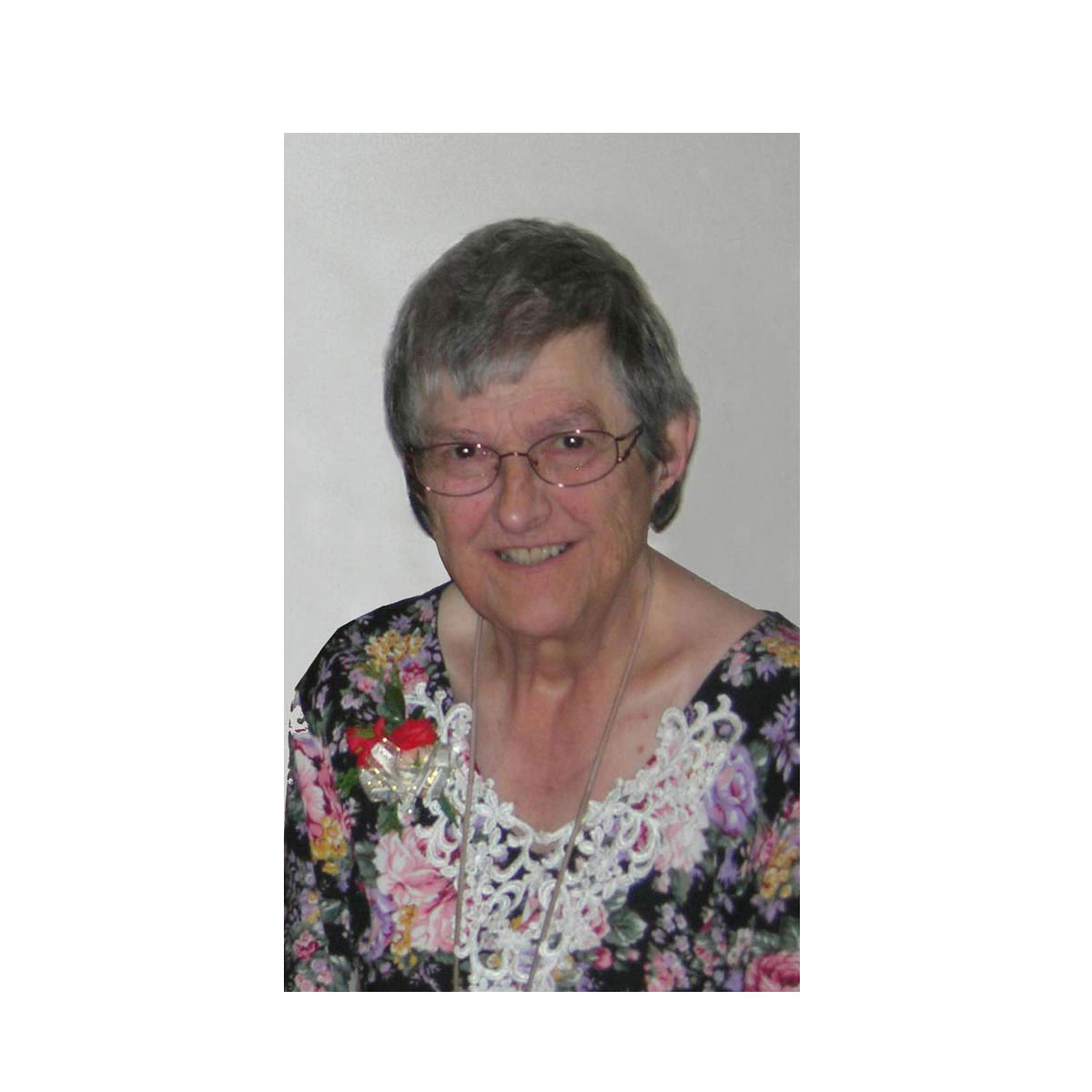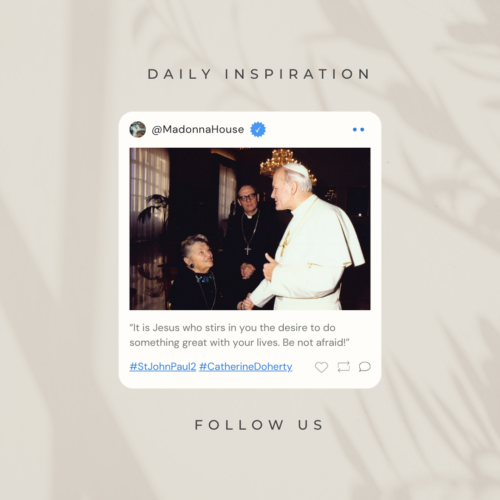This content has been archived. It may no longer be relevant
Jeannine’s story is not dramatic, but it is a beautiful one of God’s quiet, hidden work deep within the heart.
When I asked Jeannine about her childhood, the first thing she said was, “We were poor.” She was French Canadian and born in 1931 in Montreal during the Depression.
At the time, her father had already been out of work for two years and—though he worked on and off—it wasn’t until she was five that he was able to find a full-time, secure job as a grounds-keeper and handyman for a convent. For seven years, then, it was her mother who supported the family by working in a shoe factory.
But if Jeannine was poor in money and the things money buys, in another far more important way, she was rich. She had a relationship with God.
She attended a Catholic school, and as soon as the nuns started to tell her about Jesus, she was very attracted to him and to Our Lady.
Her father’s work turned out to be a blessing for Jeannine in more ways than one.
With the job came a house for the family to live in, and very near the convent was a seminary which contained a chapel the little girl could visit.
At a time and place when most churches were large, this one was tiny. That, in Jeannine’s mind, was the best part about it. She wanted to be as close to Jesus as she could, and when she knelt at the altar rail, she was very close to the tabernacle.
In grade four, when she was asked to write a composition on what she wanted to be when she grew up, she wrote that she wanted to be a nun.
But when she told her mother about her desire, her mother let her know that she didn’t like the idea at all. So Jeannine didn’t talk about it any more.
As with all the other important things she thought and felt, this desire was unshared with anyone.
“When I was a child, I was never able to really talk with my mother,” she said, “or my father or my sister. And I never had a best friend.”
By the time she was in high school, Jeannine knew that she wasn’t called to be a nun; but she did know that she wanted to give her life to God.
But how? At the time, there seemed to be only one avenue open to her: she became a registered nurse. She did nursing for six or seven years; but, as time went on, she realized that it did not give her what she longed for. She wanted something deeper.
At 29 years old, after a retreat given by an Oblate priest, she decided to try out the vocation of the Lay Oblates of Mary Immaculate, a newly formed secular institute.
While she was there, emotional problems began to surface in her. Her spiritual director, knowing she needed help, gave her the name of a priest-psychoanalyst. She was willing to do whatever needed to be done to solve her problems, but he didn’t psychoanalyze her. He merely told her that she wanted to be loved—and suggested that she get married.
This did not seem to her to be the answer. “You can’t get married just to be loved,” she thought. “You can’t just draw on a man like that. You’d only drain him out. I have to learn how to give love.”
She went to another psychiatrist, one who happened to be a good friend of Madonna House. Dr. Voyer told her that he didn’t think she was called to marriage and suggested that she visit Madonna House and talk to Catherine Doherty.
Jeannine decided to go there —in spite of the fact that she knew only a little English. After all, it was just for a weekend. But when she arrived, she found that Catherine was away and wouldn’t be back for three weeks. So Jeannine asked if she could stay until then.
God must have planned to have Catherine away at just that time; for, in those three weeks, Jeannine fell in love with Madonna House.
When she and Catherine finally met, Catherine—in her characteristically direct way—asked what she wanted. And just as directly, Jeannine answered: “I want to learn how to love.”
Catherine told her to return to Montreal and continue seeing Dr. Voyer; and when he said that she was ready, she could return to Madonna House. And so she did. After five or six more sessions, Dr. Voyer gave her the go-ahead.
She returned to Combermere and stayed.
Paulette Curran
excerpted from Restoration March 1999
***
When we join Madonna House, we are asked to write a short summary of how and why we came to Combermere. I’d like to share with you the last paragraph of what Jeannine wrote.
“As I considered this vocation to the lay apostolate, I knew from my experience with the Oblates the kind of struggles and trials of life I would have to live—fighting against my selfishness, dying to myself—all for the love of God, my Father in heaven, who gives me all and to whom I can give so little, my nothingness. Thanks be to him.”
Jeannine’s apostolic life began with a few months at our house in Portland, Oregon, and then she moved on to our soup kitchen, Marian Centre in Edmonton where she worked alongside Dorothy Phillips, the founding director, for seven years.
One story she told of that time was of a day when they had no bread. Dot told Jeannine to begin preparations to assemble sandwiches anyway. This seemed crazy to Jeannine, but she obeyed and started laying things out. Sure enough, just in time, a truck pulled up with a donation of bread. It was at Marian Centre that Jeannine learned to trust in God’s providence.
After Jeannine returned to Combermere, she spent many years working in the gift shop and pioneer museum where she enjoyed the contact with the local people, especially the children. And many an evening found her finishing up the bookkeeping for the shop.
Around 2009, Jeannine began working at our main office writing thank you notes for donations and doing the myriad of little jobs that come with office work.
You know you write powerful thank you notes when the benefactors start directing their letters to you. As department head of the office, I can attest to the fact that Jeannine befriended and became a regular correspondent with many benefactors.
Jeannine loved the Church and the Mass. We will miss her daily petition at Mass: “for the protection of the unborn and a greater respect for life.” This petition came from an encounter she had many years ago with a young woman in Edmonton who asked for prayers ; she was considering having an abortion. Jeannine took this on as a lifelong prayer.
Jeannine painted, impressionist-style water colors—of trees and birds and sunsets among other things. She liked games and puzzles, both jigsaw and crossword, and playing cards. And if a game was not forth-coming at our evening teatime, she seemed quite content with a game of Solitaire or a puzzle book.
Mary McGoff
excerpted from her funeral eulogy
***
In the few days after Jeannine’s death, people talked about her hiddenness, her childlikeness, her littleness, her suffering—and her holiness.
We do know that she suffered much. She for sure had emotional pain, and as she got older, she also suffered for many years from chronic physical pain.
Jeannine was quiet, socially awkward, and difficult to have a conversation with, and she was living in a foreign culture. She spent a lot of time alone, and she must have suffered much from loneliness even in the midst of our community.
You could sense that Jeannine had a deep prayer life. She would share words God gave her in poustinia, and her sharings at spiritual reading time were often profound.
At her memories’ night, some young staff knew and others were touched to discover that, without knowing who they were, Jeannine had prayed for them. For she regularly prayed for future staff in their mothers’ womb.
Love was her top priority when she first came to Madonna House; it must have also been so at the end. All the readings she chose for her funeral Mass were about love.
And now we rejoice with Jeannine for: It is those who are poor in the world that God chose to be rich in faith and to be heirs to the kingdom, which he promised to those who love him (James 2:5).
Paulette Curran





